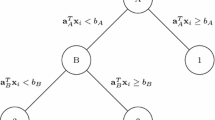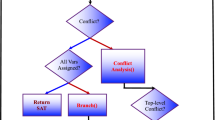Abstract
Constraint Satisfaction Problems (CSPs) are in general NP-hard, and a general deterministic polynomial time algorithm is not known. They play a central role in real-life problems. The satisfaction of a Conjunctive Normal Form (CNF-SAT)is the core of any CSP. We present a new modelisation technique for any CSP with finite variable domains, and, in particular, for solving CNF-SAT. The knowledge representation is based on two fundamental types of constraint: the choice constraint, and the exclusion constraint. These models are then implemented by means of several different neural networks, some based on backpropagation learning and others on different procedures. All these networks are trained through a supervised procedure, and learn to efficiently solve CNF-SAT. The results of significant tests are described: they show that some networks can effectively solve the proposed problems.
Similar content being viewed by others
References
Rich E. Artificial Intelligence. McGraw-Hill, New York, NY, 1983
Daniel L. Planning and operation research.Artificial Intelligence. Eisenstadt, Harper & Row, 1983
Grant T. Lessons for O.R. from A.I.: A scheduling case study.J Operat Res Soc 1986; 37 (1)
Phelps RI. Artificial intelligence —an overview of similarities with O.R.J Operat Res Soc 1986; 37 (1)
Sussman, GJ, Steele Jr, GL. Constraints: A language for expressing a most-hierarchical descriptions. Artif Intell 1980; 14
Mackworth AK, Freuder, EC, Eds. Special volume: constraint-based reasoning. Artif Intell 1992;58
Parker RG, Rardin RL.Discrete Optimization. Academic Press, San Diego, CA, 1988
Garegy MR, Johnson DS.Computer and Intractability. Freeman, San Francisco, CA, 1979
Fox M. Why is scheduling difficult? A CSP perspective.ECAI' 90 Proc 1990; Stockholm, Sweden
Monfroglio A. General heuristics for logic constraint satisfaction.Proc 1st AIIA Conf 1989; Trento, Italy
Gallo G, Urbani G. Algorithms for testing the satisfiability of propositional formulae.J Logic Program 1989
Freuder EC. A sufficient condition of backtrack-free search.J ACM 1982; 29 (1)
Mitchell D, Selman, B, Levesque, H. Hard and easy distributions for SAT problems.Proc Tenth Nat Conf Artif Intell (AAAI-92) 1992; 459–465
Monfroglio A. Connectionist networks for constraint satisfaction. Neurocomputing, 1991; 3(1)
Franco J, Pauli M. Probabilistic analysis of the Davis Putman procedure for solving the satisfiability problem. Discrete Appl Math 1983; 5
Pao YH. Adaptive Pattern Recognition and Neural Networks. Addison-Wesley, Reading MA, 1989
Samad T. Back-propagation extensions.Honeywell SSDC Tech. Rep., MN, 1989
Wilensky G, Manukian N. The projection neural network. Proc Int Joint Conf Neural Networks 1992; Baltimore, MD, Vol. II, pp. 358–367
Leonard JA, Kramer MA, Ungar LH. Using radial basis functions to approximate a function and its error bounds. IEEE Trans Neural Net 1992; 3 (4): 624–627
Moody J, Darken CJ. Fast learning in networks of locally tuned processing units.Neural Computation 1989; 1: 281–294
Fahlman SE, Lebiere C. The Cascade correlation learning architecture. School of Computer Science Report CMU-CS-90-100. Pittsburgh PA, Carnegie Mellon Univ., 1990
Kohonen T. Self-Organization and Associative Memory. Springer-Verlag, New York, 1988
Willshaw DJ, Von der Malsburg C. How patterned neural connections can be set up by self-organization. Proc R Soc London 1976; 194
DeSieno D. Adding a conscience to competitive learning. Proc 2nd Ann IEEE Int Conf Neural Networks 1988; Vol I
Batchelor BG, Practical Approach to Pattern Recognition. Plenum Press, New York, NY, 1974
Specht DF. Probabilistic neural networks. Neural Networks (1990)
Klimasauskas CC. Neural Computing (manual for NeuralWorks, NeuralWare, Inc., Pittsburgh, PA, 1991. (1993 (version 5))
Simonis H, Dincbas M. Propositional calculus problems in CHIP. Lecture Notes in Computer Science, Algebraic and Logic Programming, 2nd Int. Conf., Nancy, France, 1990, H. Kirchner and W. Wechler, Eds, Springer-Verlag, 1990, pp. 189–203
Yinyu, Y. A ‘build-down’ scheme for linear programming.Math Program 1990; 46: 61–72
Monfroglio A. Neural networks for constraint satisfaction. Lecture Notes in Artificial Intelligence, Vol. 728, Pietro Torasso editor, Advances in Artificial Intelligence, third Congress of APIA, Torino, Italy 1993; pp. 102–107
Monfroglio A. Integer programs for logic constraint satisfaction.Theor Comput Sci 1992; 97: 105–130
Monfroglio A. Neural logic constraint solving.J Parallel Distributed Comput 1994; 20 (1): 92–98
Author information
Authors and Affiliations
Rights and permissions
About this article
Cite this article
Monfroglio, A. Neural networks for finite constraint satisfaction. Neural Comput & Applic 3, 78–100 (1995). https://doi.org/10.1007/BF01421960
Received:
Issue Date:
DOI: https://doi.org/10.1007/BF01421960




